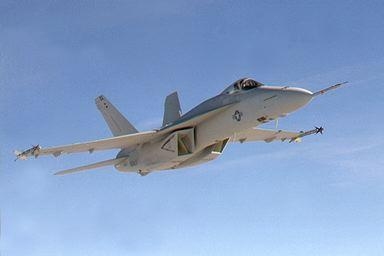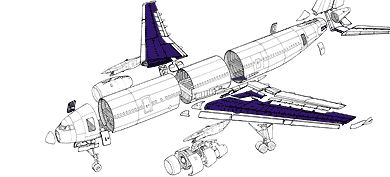



Main menu
 |
 |
 |
||
| AIRCRAFT |  |
|||
Main menu |
||||
Carbon fibre plays a major role in the production of modern aircraft. From military use in the 70's and 80's carbon fibre has become cheap enough for use in large civil airliners and now even in light recreational aircraft.
 |
This is the Boeing F/A 18 "Super Hornet" - the US Navy's flagship jet fighter. Carbon fibre is used extensively in its construction due to its lightweight properties. In fact it is so light that its weight/ thrust ratio is greater than 1:1 (in other words it can climb vertically upwards and still accelerate!). |
Boeing photo |
A military aircraft such as this will need to be able to withstand tremendous forces so engineers need to look for a material which is very strong, but cannot afford to sacrifice weight. This means that materials such as steel are too heavy for such a purpose. Carbon fibre is ideal for this application as it can be shaped to fit any part of the aircraft such as an air intake and due to its high strength (Carbon fibre reinforced plastic has a strength rating of 600Mpa)1 and low density (1500kg /m3) 1 the more carbon fibre which is used, the larger the benefits over over heavier materials. The only main problem with this is carbon fibre is very expensive. Below is a table which details the difference in price for aircraft materials.

As you can see, carbon fibre is very expensive indeed when compared to other materials used for production of aircraft. However carbon fibre still has to be used for certain aspects of aircraft design.
 |
Carbon fibre is used to reinforce wings of very large airliners such as the Boeing 747 or the Airbus A340 (pictured here). One use is to cover struts in the wing's structure. |
Picture Airbus Industrie |
So why is carbon fibre used in this way?
Take a look at this table
| Material | Tensile Strength (GPa) | Tensile Modulus (GPa) | Density (g/ccm) | Specific Strength (GPa) | |
| Standard Grade Carbon Fibre | 3.5 |
230.0 |
1.75 |
2.00 |
|
|---|---|---|---|---|---|
| High Tensile Steel | 1.3 |
210.0 |
7.87 |
0.17 |
The tensile strength of carbon fibre lends itself very well to being used on aeroplane wing struts due to the wing flexing in flght. This flexing places great stress on the wing struts over time and carbon fibre is used to prevent any cracks forming in the wing. Compared to high tensile steel carbon fibre shows how much lighter it is - obviously this is very important for use in a wing structure which has to keep weight to a minimum. Carbon fibre also has a much higher strength than steel (in fact its strength is higher than nearly all other metals) so it is perfect for making safe aircraft.
Another use for carbon fibre is in the world's most technologically advanced airliner, the Boeing 777. Due to carbon fibre's flexibility, it has been possible to constuct a perfectly round fuselage - which reduces fatigue in the airframe, something of great importance to a safety conscious public.
However due to the high price of carbon fibre, civilian aircraft cannot afford to have large sections of carbon fibre. This is not too much of a problem, because a large airliner would not be significantly lighter due to the large amount of fuel and passengers they already carry. However carbon fibre is used sparingly as sometimes there is no other material which can serve such a purpose.
An example of this type of use is in the space shuttle
|
During re-entry back into the atmosphere, the space shuttle experiences temperatures in excess of 2000oC . NASA engineers needed to find a material which retains its strength at these temperatures.
Carbon fibre was chosen as it loses no structural integrity even at temperatures as high as 2500oC. However constucting the whole vehicle out of carbon fibre would have meant huge expense so the main body of the shuttle was constructed of aluminium, which has enough strength for the majority of the shuttle's body. However aluminium has a low melting point (660oC)2 which is much too low for the area of the shuttle which experiences the highest temperatures - the nose cone. Instead the nose cone is constucted of carbon fibre which will remain structurally sound at these temperatures.
The top of the shuttle will not experience such temperatures and can be safely made from the much cheaper aluminium.
So in conclusion, carbon fibre is the ideal material for use in the aircraft industry as it has superb properties - low density, high tensile strength, strength at high temperatures. Its only downfall is the sheer expense of production and because of this aircraft designers cannot use as much carbon fibre as they would like. However some structural areas of aviation have benefitted greatly from sparing use of carbon fibre, enabling companies to build large, economically viable airliners with enormous wing area with no risk of structural failure. Also, the advancement of space technology is including carbon fibre more frequently as engineers find it beneficial over metallic materials and as the price of carbon fibre begins to drop.
1 Advancing physics CD-ROM materials database - pricing data also from this source
2 Figure from http://www.matweb.com